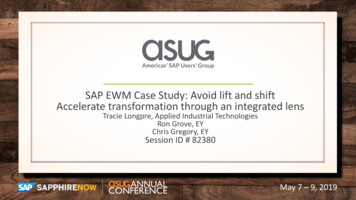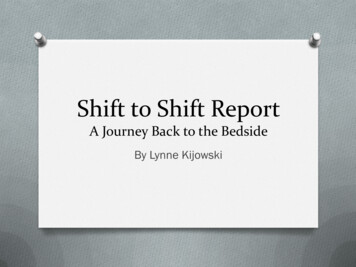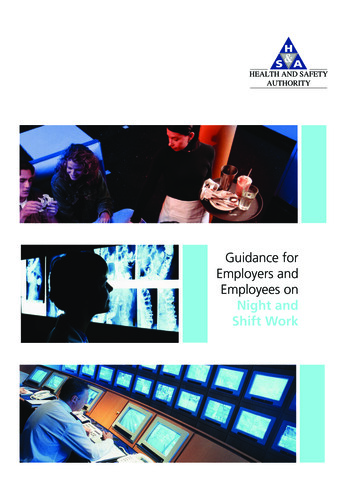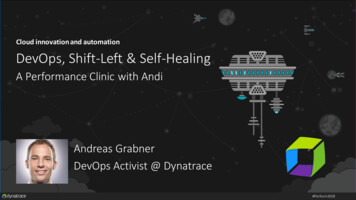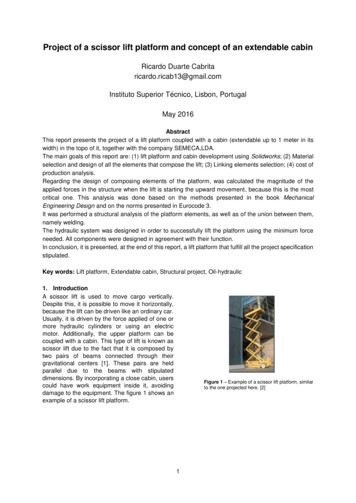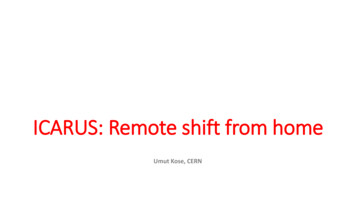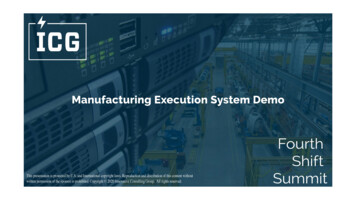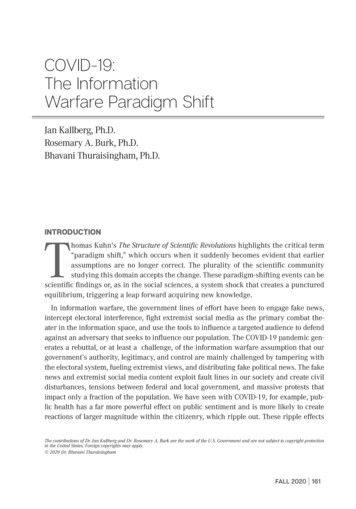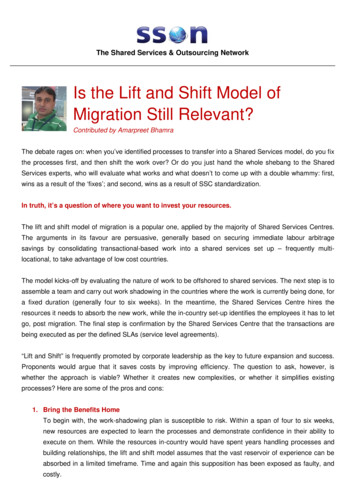
Transcription
The Shared Services & Outsourcing NetworkIs the Lift and Shift Model ofMigration Still Relevant?Contributed by Amarpreet BhamraThe debate rages on: when you’ve identified processes to transfer into a Shared Services model, do you fixthe processes first, and then shift the work over? Or do you just hand the whole shebang to the SharedServices experts, who will evaluate what works and what doesn’t to come up with a double whammy: first,wins as a result of the ‘fixes’; and second, wins as a result of SSC standardization.In truth, it’s a question of where you want to invest your resources.The lift and shift model of migration is a popular one, applied by the majority of Shared Services Centres.The arguments in its favour are persuasive, generally based on securing immediate labour arbitragesavings by consolidating transactional-based work into a shared services set up – frequently multilocational, to take advantage of low cost countries.The model kicks-off by evaluating the nature of work to be offshored to shared services. The next step is toassemble a team and carry out work shadowing in the countries where the work is currently being done, fora fixed duration (generally four to six weeks). In the meantime, the Shared Services Centre hires theresources it needs to absorb the new work, while the in-country set-up identifies the employees it has to letgo, post migration. The final step is confirmation by the Shared Services Centre that the transactions arebeing executed as per the defined SLAs (service level agreements).“Lift and Shift” is frequently promoted by corporate leadership as the key to future expansion and success.Proponents would argue that it saves costs by improving efficiency. The question to ask, however, iswhether the approach is viable? Whether it creates new complexities, or whether it simplifies existingprocesses? Here are some of the pros and cons:1. Bring the Benefits HomeTo begin with, the work-shadowing plan is susceptible to risk. Within a span of four to six weeks,new resources are expected to learn the processes and demonstrate confidence in their ability toexecute on them. While the resources in-country would have spent years handling processes andbuilding relationships, the lift and shift model assumes that the vast reservoir of experience can beabsorbed in a limited timeframe. Time and again this supposition has been exposed as faulty, andcostly.
2. Pressure to meet SLAs, ASAPTime is a core element in lift and shift. Post offshoring, the shared services teams are expected tomeet the SLAs associated with the process fairly quickly. This places stress on the team andresources, and can lead to slippages in performance management, or even churn in staff. Thoughthese are routine activities, resources need time to mature and thereby contribute to metricsdeliveries. There is also a tendency to skim through the stabilization phase, as the country is waitingto secure labour arbitrage gains. Shortcuts are costly.3. Process complexity: S.O.S.Another perspective relates to complexities linked to performance management in this model. Forexample, a recent case involved in-country operations for a manufacturing company offshoringinvoicing to a Shared Services Centre. The SSC team encountered backlogs, however, as thescanning tool was unable to handle the volumes, thus requiring the vendor’s intervention. As theSSC team had not yet established a relationship with the vendor, this led to a ‘blame game’between country and SSC leadership over the ability to handle the process. Complexity tends to bemultiplied when migration involves tools and automations, as the new team needs time tounderstand the interface of these tools with the ERP system, and in the event of a breakdown,access to subject matter expertise or knowledge base is limited, as the in-country employees havemoved on. It can easily happen, therefore, that shared services struggles to meet the expectationsof the retained organization.4. Beware of ERP upgrades, adding to complexity and costProcess complexity and cost increases with any implementation or upgrade related to ERPsystems. First, because the process is offshored with existing inefficiencies, meaning there will becosts related to standardization. Second, because in the absence of analytical rigour forecastingwhether offshored processes need reengineering post ERP upgrade, there is little visibility overadditional costs. Third, because there is little visibility over how compatible tools and automationsare with the ERP system. Fourth, because although the SSC may have established a track recordfor service delivery, the ERP perspective may demand competence in process transformations,which might not be strongly established, and therefore may imply some dependence on employeesin-country for process transformations. Fifth, because the shared services may have to invest inmassive internal change management as the ERP overhaul leads to a shift from transactional tobusiness metrics. There would be much merit in addressing these points prior to the transition.5. Validating winsIt is often surprisingly difficult to validate the gains for lift and shift transitions. Headcountreconciliations between the country and the shared services may yield unforeseen surprises. Forexample, the country could be working from a reduced, “post transition” headcount, but may, forwhatever reason, not end up letting go of the staff, putting a question mark on accrued labourarbitrage savings. Moreover, budgets related to manpower, travel, training and infrastructure needwww.ssonetwork.com www.ssoweek.com2
to be screened to avoid future gaps. A strong governance framework will minimise suchshortcomings.6. Relationship buildingBusiness partnering and forging relationships is a critical driver of success, particularly in a newshared services environment. In this context, SSC leaders need to continue to invest inrelationships with all parties, even if some are not impacted by the offshoring of work. Leadersshould also take the initiative to visit vendor-managed operations to build good relations.Everything should be done to establish strong relations between shared services leadership and theretained organization in-country. There may be benefit in hosting forums with Sales, Marketing andHR in-country, to address gaps in governance and nip potential detractors of offshoring in the bud.Furthermore, it’s a good idea to rotate staff between the retained organization and the sharedservices team to promote relationship-building and dispel any lurking criticisms. On the other hand,shared services should be warned off slipping into their own comfort zone, or effectively recreating aseparate organizational silo.7. While the arguments above relate to captive shared services, the same issues apply to outsourcingto third party providers. In fact, in a recent interview with ‘The Financial Express’, Erich Clementi,General Manager for IBM’s managed business process portfolio, said that as pressure increases,traditional business process outsourcing, which relies on labour arbitrage, is no longer enough:“The approach today is very different as we are not just taking over process but transformingbusinesses. Companies are burdened with inefficiently high pain points, increasing costs andpressure to deliver. As the pressures increase businesses are looking to derive a new kind ofvalue from their service providers a partner who can help them rethink their business models andbusiness operations.”Which begs the question whether outsourcing in the traditional sense still makes sense, when somany inhouse leaders can now access technologies that offer lots of opportunity to manage andtransform processes.Amarpreet Bhamra is a business process management professional with sixteen years diverse workexperience in Logistics and Supply Chain, Telecom, Financial Services, e-learning and media verticalsacross both shared services centers and third party business process outsourcing firms.He has completed an Executive Program in Leadership and Management (Indian Institute of ManagementCalcutta), holds certifications in LEAN Six Sigma Black Belt-Anexas, Six Sigma Green Belt-GE Capital,Internal Assessor-TATA Management Training Center and Coaching-Corporate Coach U. His currentresponsibility is as a Global Quality Lead for an F&A vertical in India. He is a regular columnist for SSON.Interested in topics like this? Learn more about our upcoming 15th Annual European Shared Services &Outsourcing Week, 19 - 21 May, 2015 - Beurs van Berlage, Amsterdam, The Netherlands.www.ssonetwork.com www.ssoweek.com3
The European Shared Services & Outsourcing Week remains Europe’s premiere conference dedicated tothe shared services and outsourcing history. Gather over 500 practitioners, GBS leaders, analysts andindustry experts, we provide the ideal platform for meaningful benchmarking, networking and learning.View more resources in our Download Centre.www.ssonetwork.com www.ssoweek.com4
are with the ERP system. Fourth, because although the SSC may have established a track record for service delivery, the ERP perspective may demand competence in process transformations, which might not be strongly established, and therefore may imply some dependence on employees in-country for process transformations.
